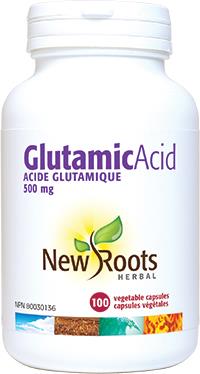New Roots Glutamic Acid 100Vcaps NEW ROOTS
$ 16,50 $ 9,90
New Roots Glutamic Acid
Glutamic acid is a nonessential amino acid used by the body to manufacture human protein, a vital component of all the body’s cells. This amino acid is labeled “nonessential” because, when the acids are lacking in the diet, the body can manufacture them. All nonessential amino acids must be on-hand before the body can synthesize protein; several have additional, more specialized roles as well. Glutamic acid is biosynthesized from a number of amino acids, including ornithine and arginine. When aminated, glutamic acid forms the important amino acid glutamine. Because it has a carboxylic acid moiety (functional group) on the side chain, glutamic acid is one of only two amino acids (the other being aspartic acid) that has a net negative charge at physiological pH. This negative charge makes glutamic acid a very polar molecule, and it is usually found on the outside of proteins and enzymes, where it is free to interact with the aqueous intracellular surroundings.
It is an organic compound, one of the 20 amino acids commonly found in animal proteins. Only the l stereoisomer occurs in mammalian proteins. Like aspartic acid, glutamic acid has an acidic carboxyl group on its side chain, which can serve as both an acceptor and a donor of ammonia, a compound toxic to the body. Once glutamic acid has coupled with ammonia, it is called glutamine and can as such safely transport ammonia to the liver, where the ammonia is eventually converted to urea for excretion by the kidneys. Free glutamic acid (not incorporated into proteins) can also be converted reversibly to ketoglutaric acid, an intermediate in the Krebs cycle, and as such can be degraded to carbon dioxide and water, or transformed into sugars. The acidic side chain of glutamic acid confers one negative charge under most conditions to proteins in which this amino acid is found, thus increasing the water solubility of the protein.
Glutamic acid is an important excitatory neurotransmitter, necessary in the metabolism of sugars and fats, and supports prostate function.
Directions:
Take 3 capsules daily with meals and water or as directed by your health-care practitioner.
| Each vegetable capsule contains: | |
| l‑Glutamic acid | 500 mg |
| Other ingredients: Vegetable magnesium stearate, microcrystalline cellulose, and silicon dioxide in a non‑GMO vegetable capsule composed of vegetable carbohydrate gum and purified water. | |
Fast Shipping with Professional Packaging
Due to our longstanding partnership with UPS FedEx DHL as well as other top international carriers, we are able to offer a variety shipping options. Our warehouse staff are trained to pack your goods precisely according to the specifications we offer. Your items are carefully inspected and secured properly prior to shipping. Everyday, we send to thousands of customers in many countries. The fact that we are committed to becoming the biggest online retailer in the world is obvious. Both Europe and the USA have warehouses and distribution centers.
Note: Orders with more than one item are assigned a processing period in accordance with the item.
Before shipment, all ordered items will be thoroughly examined. The majority of orders will be sent within 48 hours. The delivery time is between 3-7 days.
Returns
Due to multiple parties which include the factory as well as the warehouse, we cannot fully manage stock. The actual levels of stock can change at any point. It's possible that you may not receive your order after it's been placed.
Our policy lasts thirty days. If it's been more 30 days since you made your purchase We're sorry to say that we can't offer you a complete exchange or refund.
The item must not be used and in its original condition. The item must be in its original packaging.
Related products
BENFOTIAMINE
CURCUMIN-95
C+BIOFLAVONOIDS
SABALASAN PROSTATE 1
ECHINAFORCE
CYSTOFORCE
ADVANCED B COMPLEX
L-CARNITINE
CITICOLINE
PASSION FLOWER
THYROID SUPPORT
INOSITOL POWDER
ACTIVE GREEN TEA
CARDANA CAPS
SABALASAN PROSTATE 1
INOSITOL
BONE BASICS
GASTRO RELIEF
BIO STRATH
ECHINAFORCE EXTRA 1200MG
ESTRO ADAPT
ADVANCED B COMPLEX
ABSOLUT ARNICA
VENAFORCE GEL
BRONCHOSAN
GINKGOFORCE


































